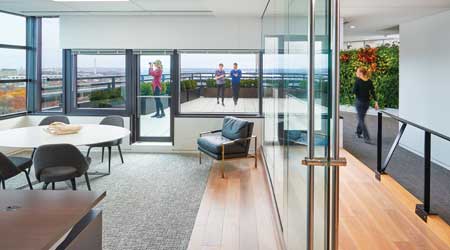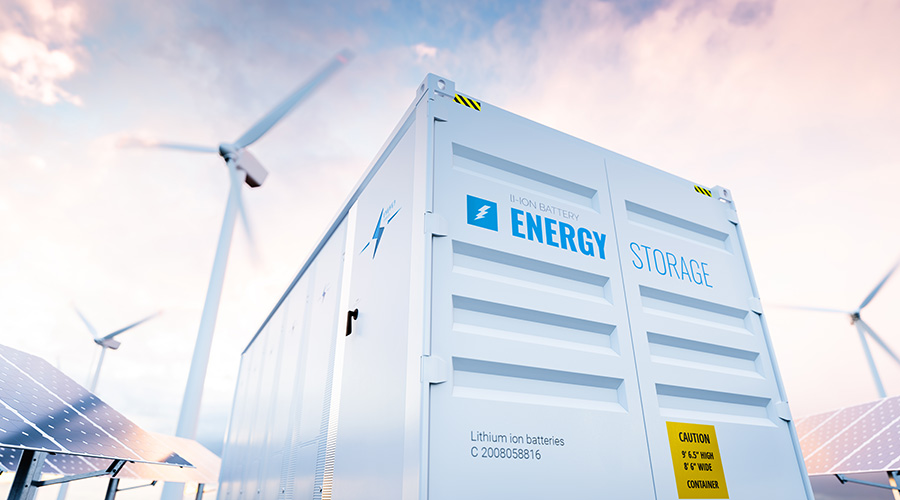 As facility managers look for ways to create tenant amenities, they should look to outdoor spaces that can be captured and repurposed.
Credit: Judy Davis
As facility managers look for ways to create tenant amenities, they should look to outdoor spaces that can be captured and repurposed.
Credit: Judy DavisSmart Strategies for Creating Sustainable Outdoor Workspaces
Nature's restorative effects can improve workers' abilities to pay attention and focus. Here are some tips for bringing the outdoors in and the indoors out.
The most effective workspaces are human-centric, and amplify the message that people are a company’s most important resource. There are several primary attributes to any truly compelling, people-first workplace: an urban vibe, with a buzz of activity that feels like a place where something important is happening; a collegial atmosphere where employees are part of something bigger, and their contribution is recognized and important; and they allow a “walk in the park.”
Everyone needs a break from time-to-time. We need to regroup, regenerate, and rest. An effective workplace supports this. Maybe it’s as simple as a view, or integrating interior planting, or even literally a walk in the park across the street. It’s an often overlooked feature, and it can have a profound influence on the success of an office.
Integrating nature and the office building
Nature impacts human well-being at a fundamental level and can measurably reduce levels of fear and stress. Nature can soothe and even reduce pain. It’s no accident that hospitals and other institutional settings increasingly try to integrate nature and outdoors into design.
Nature’s restorative effects can improve one’s ability to pay attention and focus. A break can improve our ability to refresh and come back ready to take on new tasks. A workplace that can integrate nature is one that can truly make people healthier when they go home than when they arrived in the morning.
The coronavirus pandemic has accelerated this thinking as building owners and facility managers contemplate the next level of effective workplaces with renewed attention to not only actual outdoor spaces, but indoor atriums, and even interior community spaces. There is great interest in how to create this connection to nature or make existing spaces or underutilized features into effective workspaces, particularly with the knowledge that the transmissibility of the virus is significantly reduced in outdoor settings. In fact, many schools and colleges are contemplating outdoor instructional settings where facilities and weather permit.
The workplace is not far behind and the close connection between interior architecture and landscape architecture is being amplified as effective rooms are developed both indoors and out for small group settings, for team spaces, for brainstorming sessions, and alternative solo work seats.
A place for rest and a place for work
Historically, outdoor settings have been places to be seen, but not necessarily to have been occupied for a work day. Increasingly we’re seeing these spaces with a renewed focus, not simply as beautiful ambiance, but as a functional space as well. They can provide the needed respite for stressed employees, but they can also be effective work settings. Even in generally inhospitable climates, with a bit of shelter and even heat on a cool day or cooling on a warm one, outdoor settings can work as highly effective spaces akin to effective interior spaces. Often these outdoor spaces are literally extensions of interior community spaces with materials and features that make the inside and outside blend seamlessly.
As facility managers look for ways to amplify the features of their portfolio, they should look to outdoor spaces that can be captured and repurposed as another tenant amenity in the arms race to attract and retain tenants. An exciting feature of this trend is in existing buildings where underutilized roof decks, parking garage roofs, or balconies become features that one or more tenants can use. Something as simple as a physical connection between the bustle of an active building lobby and recaptured but adjacent outdoor space can provide an entirely new and very welcome experience for tenants. And it supports the idea of a compelling, human-centric work experience. Facility managers must ask themselves: What will make individuals come to the office from the relative safety of their homes? The experience, the amenity, and the chance to work effectively with colleagues must be compelling.
Making the outdoors work for work
Effective outdoor workspaces have the same requirements as their interior cousins: Furnishings should be flexible and movable. Materials should be inviting and welcoming. Technology can transform a space from a simple arrangement of chairs to a real and effective team space or collaboration zone. Robust and seamless network connectivity is a must. Lighting (or shade) should allow screens to be visible and for participants to be seen. The new normal will always have virtual participants whether the meeting and the participants are inside or out.
Spaces need not, however, be a collection of interior rooms simply moved outdoors. A top that can provide some level of shading, visual privacy from above, and some ability to withstand moisture makes the space habitable in all but extreme conditions. Some settings provide cooling to extend their use further into warm weather and heat to do the opposite in cool climates. While the very hottest days, a heavy downpour, the onset of frigid weather, or a snowstorm may render a space inoperable, facility occupants will appreciate how much of the year an outdoor setting can be effective and serve as a productive workplace.
Related Topics:













